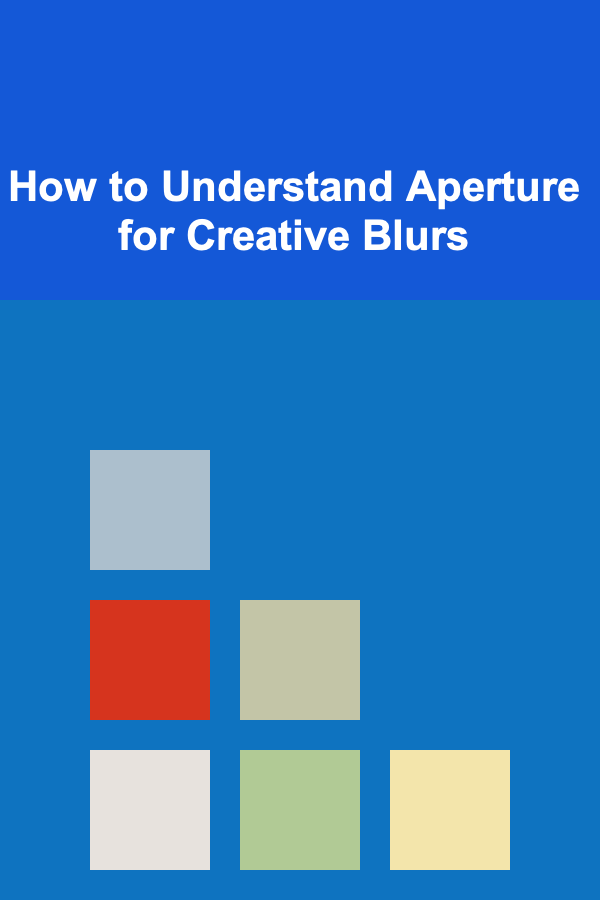
How to Understand Aperture for Creative Blurs
ebook include PDF & Audio bundle (Micro Guide)
$12.99$10.99
Limited Time Offer! Order within the next:

Photography is an art, and like any form of art, it allows the photographer to express emotion, convey meaning, and tell stories through visual composition. One of the most powerful techniques in photography is the ability to manipulate depth of field (DOF) to create blurred effects in an image. The aperture setting plays a critical role in this manipulation, as it controls both the amount of light entering the camera and the depth of field, allowing you to craft creative and intentional blur effects.
In this article, we will explore the relationship between aperture and creative blurs, how aperture settings affect your photos, and practical tips for using aperture to create stunning bokeh and blur effects. By understanding aperture, you can take full control over your creative process and make your images stand out.
What is Aperture?
Aperture refers to the opening in a camera lens that allows light to pass through to the image sensor (or film, in the case of traditional photography). It is typically controlled by a set of blades inside the lens, which can open and close to regulate the size of the opening. The size of the aperture is measured in f-stops, which are numerical values (such as f/1.4, f/2.8, f/5.6, f/16).
An aperture setting is written as f/n, where "n" represents the f-stop number. Smaller numbers (e.g., f/1.4) mean a larger aperture opening, allowing more light to pass through, while larger numbers (e.g., f/16) indicate a smaller aperture, letting in less light.
In addition to regulating light, the aperture has a significant impact on the depth of field in your image. Depth of field refers to the range of distance in a photo that appears acceptably sharp. A shallow depth of field means that only a small portion of the image is in focus, with the rest appearing blurry. A deep depth of field means that much of the scene, from foreground to background, is in focus.
Aperture and Depth of Field
The key to understanding how aperture affects blur is to comprehend the relationship between aperture and depth of field. Here's how aperture influences DOF:
Shallow Depth of Field (Large Aperture)
When you use a large aperture (a small f-stop number like f/1.4, f/2, or f/2.8), the depth of field becomes shallow. This means that the area of the image that is in focus is very narrow, and the rest of the image, both in front of and behind the focus point, will appear blurred. This blur can be very creative and intentional when used to isolate your subject from the background.
For instance, portrait photographers often use a wide aperture to create a shallow depth of field, keeping the subject sharply in focus while blurring the background. The resulting effect is a soft, aesthetically pleasing bokeh that draws the viewer's attention to the subject.
Deep Depth of Field (Small Aperture)
On the other hand, when you use a small aperture (a large f-stop number like f/16, f/22), the depth of field increases, and more of the image will be in focus. This is useful when photographing landscapes, where you want both the foreground and background to be sharp. However, when there is motion in the scene or you want to create a more abstract image, a deep depth of field can sometimes reduce the impact of blur, making it more difficult to separate your subject from the environment.
In creative photography, you may choose to adjust the aperture to control how much of your image is in focus and how much can be blurred. Understanding how aperture settings affect depth of field allows you to better plan and control the mood and style of your photograph.
The Bokeh Effect
"Bokeh" is a term borrowed from Japanese that refers to the quality of the blur in the out-of-focus areas of an image. While bokeh itself is a blur, it's not simply any blur --- it's about the quality of that blur. Photographers intentionally manipulate aperture to create visually appealing bokeh effects, which can add a sense of atmosphere, depth, or artistry to a photo.
Factors that Influence Bokeh
- Aperture Shape: The shape of the aperture opening can affect the bokeh. Lenses with rounded aperture blades tend to produce a smoother, more circular bokeh, while lenses with more angular blades may produce bokeh that is more polygonal in shape. The number of aperture blades also affects the bokeh's appearance --- more blades usually result in a rounder bokeh.
- Aperture Size: A larger aperture (smaller f-stop number) generally results in a more pronounced bokeh effect, with a more out-of-focus background and more noticeable blurred highlights. A small aperture, on the other hand, produces less blur, and the bokeh effect becomes less noticeable.
- Lens Quality and Design: Different lenses have varying levels of ability to create bokeh. Some lenses, especially those with "fast" aperture settings (like f/1.4 or f/1.8), are known for creating particularly smooth and creamy bokeh. The optical design of the lens also plays a role in how the light is rendered in out-of-focus areas.
How to Use Aperture for Creative Bokeh
To achieve beautiful bokeh, there are a few key tips you can use when selecting aperture settings:
- Use a Wide Aperture: Set your aperture to a small f-stop number (f/1.2, f/1.4, f/2) to achieve a shallow depth of field with pronounced bokeh. This will allow the background or foreground elements to blur into soft, colorful shapes that add interest to your photo.
- Choose a Lens with a Rounded Aperture: Lenses with a rounded aperture (such as those with 9 or more aperture blades) tend to create smoother, rounder bokeh. Some lenses, such as prime lenses with wide apertures, are known for their ability to produce beautiful bokeh.
- Focus on Light Sources: Bokeh effects are often most noticeable when there are light sources in the out-of-focus areas. Streetlights, fairy lights, or reflections of sunlight on a water surface can create stunning bokeh, especially if the aperture is set to a large opening. Experiment with different light sources and distances from the camera to create varying sizes and patterns of bokeh.
- Adjust the Distance Between Subject and Background: To enhance the bokeh effect, position your subject closer to the camera and place the background farther away. This exaggerates the blurring of the background, allowing the bokeh to take center stage.
Creative Uses of Aperture for Blur Effects
Aperture can be used creatively to not only blur the background but also to introduce intentional blur into the subject itself. These techniques often involve experimenting with different aperture settings, focal lengths, and even motion. Let's look at a few creative blur techniques you can try:
1. Motion Blur
One way to use aperture creatively is to incorporate motion blur in your images. While aperture itself doesn't directly control motion blur (which is primarily influenced by shutter speed), a wide aperture setting can help you achieve an artistic effect by allowing you to keep your subject in focus while the surrounding elements blur with movement.
For example, if you're photographing a person walking in front of a busy street, using a large aperture like f/2.8 can allow the person to remain in focus while the moving vehicles blur in the background, creating a dynamic and lively sense of motion.
2. Tilt-Shift Effect (Miniature Effect)
Using a wide aperture along with tilt-shift techniques (often achieved through a specialized lens or post-processing software) can create a miniature or "toy-like" effect. This technique involves using selective focus, with a narrow region in focus and the rest of the image intentionally blurred. By using aperture to control depth of field, you can create a unique, surreal effect that makes real-life scenes appear like tiny models.
3. Background Blur in Portraits
In portrait photography, using a wide aperture helps isolate the subject from the background, creating a pleasing blur that emphasizes the subject. However, the nature of the background blur can be adjusted depending on the aesthetic you want. For a soft, creamy bokeh, use a wide aperture with a lens that produces smooth blur. If you're photographing a subject in front of a textured background (e.g., leaves or lights), a smaller aperture may be used to create a different type of blur.
4. Creative Lens Choices
Beyond the aperture setting itself, the lens you choose will impact how the blur manifests in your image. Lenses with special optical designs, such as macro lenses , fisheye lenses , or vintage lenses, can create unique and artistic blur effects that complement your aperture settings.
Some photographers also experiment with lensbaby lenses or other specialty lenses to create a dreamlike, artistic blur that is both creative and eye-catching. These lenses can be used to create a radial blur effect, which draws attention to the center of the image while softly blurring the outer regions.
Conclusion
Aperture is a powerful tool that offers endless creative possibilities for photographers. By understanding how aperture affects depth of field and bokeh, and how it can be used to create intentional blur effects, you can take full control of your image-making process. Whether you're shooting portraits, landscapes, or abstract art, mastering the aperture allows you to produce images with the creative blur and bokeh effects that elevate your work.
Experiment with different aperture settings, lens choices, and focusing techniques to discover the unique blur effects that best suit your artistic vision. With practice and a deep understanding of aperture, you can push the boundaries of your creativity and create stunning, memorable images.

How to Make Your Bedroom Feel Bigger with Simple Space-Saving Tricks
Read More
How to Manage Inventory for Your Online Store with Limited Time: An Actionable Guide
Read More
How to Organize Holiday Decorations for Easy Storage
Read More
How to Repurpose Old Furniture for Laundry Storage
Read More
How to Use ChatGPT for Music Creation (Lyric Generation)
Read More
Optimizing Fiber Intake for Digestion and Weight Loss
Read MoreOther Products

How to Make Your Bedroom Feel Bigger with Simple Space-Saving Tricks
Read More
How to Manage Inventory for Your Online Store with Limited Time: An Actionable Guide
Read More
How to Organize Holiday Decorations for Easy Storage
Read More
How to Repurpose Old Furniture for Laundry Storage
Read More
How to Use ChatGPT for Music Creation (Lyric Generation)
Read More